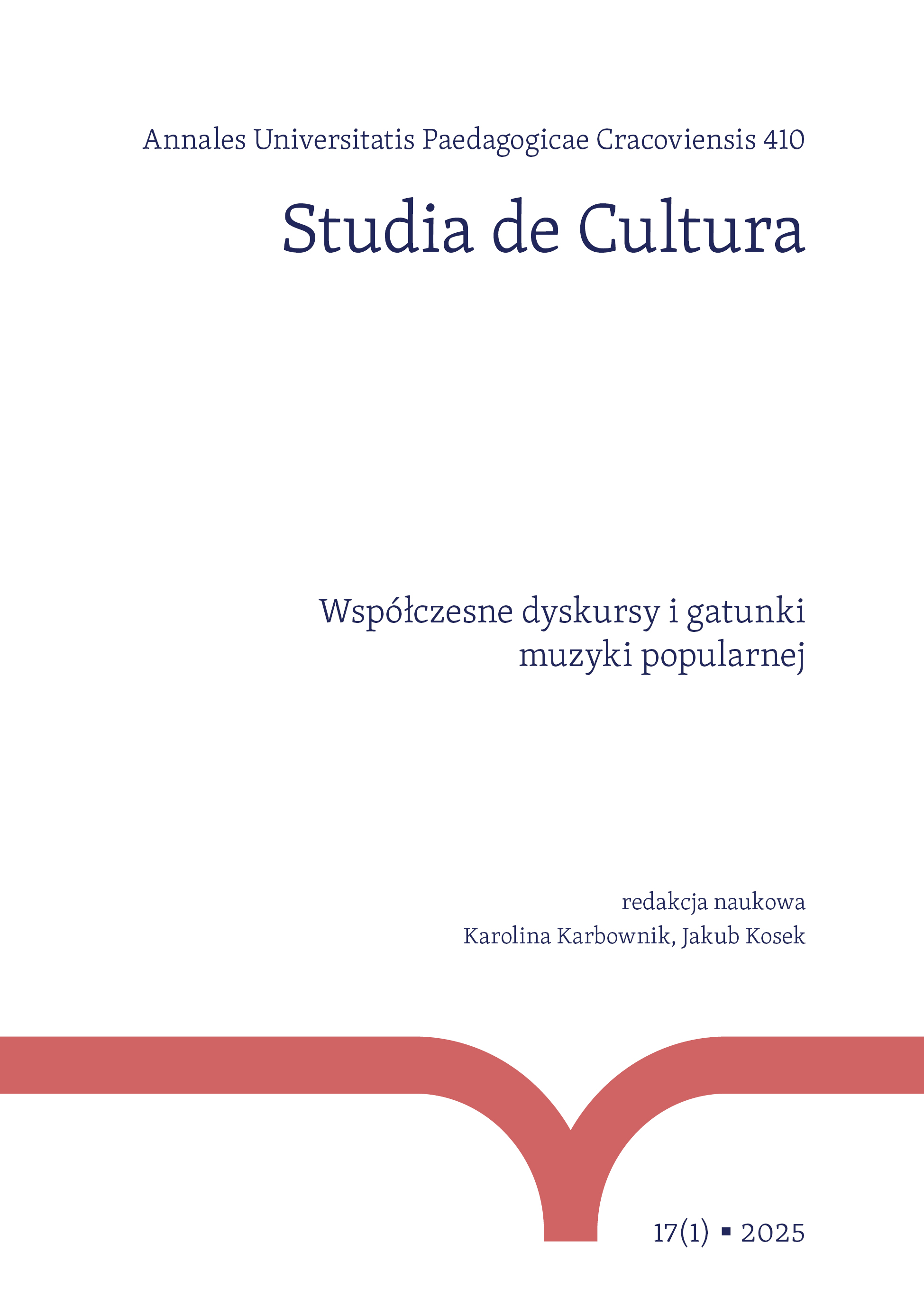Abstract
The paper analyzes corporeality in the audiovisual work of the band Tool, focusing on posthumanist and transcendental motives. Music videos for songs such as Stinkfist, Schism, and Parabola depict the disintegration of the human body, symbolizing the desire to transcend biological limits. Blending surrealism with body horror, they provoke reflection on the condition of the body in a technological world. Based on the theories of N. Katherine Hayles, Donna Haraway, Gilles Deleuze, and Giorgio Agamben, this study explores the role of audiovisual art as a medium for reflecting on the contemporary human condition in the face of technological transformation.
References
Adamiak Marzena. 2002. „Foucault i perypetie podmiotu”. Przegląd Filozoficzny nr 11, 179-200.
View in Google Scholar
Agamben Giorgio 2008. Homo sacer. Suwerenna władza i nagie życie. Mateusz Salwa (przeł.). Warszawa.
View in Google Scholar
Buda Stanisław. 1999. Zarys metafizyki absolutności. Kraków.
View in Google Scholar
Bugajska Anna. 2021. „Religia” ulepszania. Od evantropii do nieśmiertelności. W: Ulepszanie poznawcze człowieka. Perspektywa filozoficzna. Piotr Duchliński, Grzegorz Hołub (red.). Kraków. 261–279.
View in Google Scholar
Cackowski Zdzisław. 1997. Rozum między chaosem a „Dniem Siódmym” porządku. Lublin.
View in Google Scholar
Chirpaz François. 1998. Ciało. Jacek Migasiński (przeł.). Warszawa.
View in Google Scholar
Deleuze Gilles. 2017. Immanencja. Życie. Kajetan Maria Jaksender (przeł.). Kraków.
View in Google Scholar
Deleuze Gilles, Guattari Félix. 2015. 28 Listopada 1947 – jak sporządzić sobie ciało bez organów? W: Tysiąc plateau. Michał Herer (przeł.). Warszawa. 179–201.
View in Google Scholar
Grzybowski Jacek, Zembrzuski Michał. 2021. Pytania o transhumanizm – nadzieja ludzkości czy antropologiczny błąd. W: Ulepszanie poznawcze człowieka. Perspektywa filozoficzna. Piotr Duchliński, Grzegorz Hołub (red.). Kraków. 259–306.
View in Google Scholar
Haraway Donna. 2006. A Cyborg Manifesto Science, Technology, and Socialist-Feminism in the Late Twentieth Century. W: The Transgender Studies Reader. Susan Stryker, Stephen Whuttle (red.). London.
View in Google Scholar
Hayles N. Katherine. 1999. How We Became Posthuman Virtual Bodies in Cybernetics, Literature, and Informatics. London.
View in Google Scholar
Keenan Maynrad James. 1996. Stinkfist. W: Ænima.
View in Google Scholar
Klichowski Michał. 2014. Narodziny cyborgizacji. Nowa eugenika, transhumanizm i zmierzch edukacji. Toruń.
View in Google Scholar
Łątka-Płachta M. 2022. „Cyborgizacja a zasada równości, prawo do samostanowienia o sobie oraz zasada godności”. Progress Journal of Young Researchers nr 11. 127–146.
View in Google Scholar
Silburn Lilian. 1988. Kundalini: The Energy of the Depths. Paris.
View in Google Scholar
Wolska Uruszula. 2024. „Fenomem żywego ciała w tożsamości duchowo-cielesnej”. Paideia nr 6. 55–75.
View in Google Scholar
Zabdyr-Jamróz Michał. 2011. Emancypacja jako opresja. Interpretacja instytucji habeas corpus przez pryzmat Agambenowskiej koncepcji homo sacer. Kraków.
View in Google Scholar
Żółkowska Teresa. 2018. „Posthumanizm. Niepełnosprawność”. Niepełnosprawność. Dyskursy Pedagogiki Specjalnej nr 32. 27–37.
View in Google Scholar
Markiewicz Miłosz. 2016. „Myśleć kłączem (Gilles Deleuze, Félix Guattari. Tysiąc plateau)”. ArtPapier, https://artpapier.com/index.php?page=artykul&wydanie=299&artykul=5495, (dostęp: 22.02.2025).
View in Google Scholar
Mindbent. 2021. Schism Explained: Meaning & Analysis, https://mindlybiz.com/articles/music/tool/lateralus/schism/ (dostęp: 04.11.2024).
View in Google Scholar
Rampton Mike 2019. A Deep Dive Into Tool’s Sober Video, https://www.kerrang. com/a-deep-dive-into-tools-sober-video (dostęp: 04.11.2024).
View in Google Scholar
Tool. Parabola, https://www.youtube.com/watch?v=-_nQhGR0K8M dostęp: (01.09.2024–22.02.2025).
View in Google Scholar
Tool. Schism, https://www.youtube.com/watch?v=MM62wjLrgmA (dostęp: 01.09.2024–22.02.2025).
View in Google Scholar
Tool. Stinkfist, https://www.youtube.com/watch?v=6zpvlMp04D0 (dostęp: 01.09.2024–22.02.2025).
View in Google Scholar

This work is licensed under a Creative Commons Attribution-NonCommercial 4.0 International License.
Copyright (c) 2025 Annales Universitatis Paedagogicae Cracoviensis. Studia de Cultura

